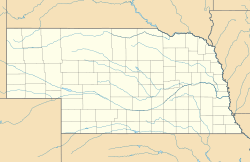Walker Gilmore Site facts for kids
|
Walker Gilmore Site (22CC28)
|
|
| Location | Northeastern quarter of the northeastern quarter of Section 28, Township 11 North, Range 14 East |
|---|---|
| Nearest city | Weeping Water, Nebraska |
| NRHP reference No. | 66000441 |
Quick facts for kids Significant dates |
|
| Added to NRHP | October 15, 1966 |
| Designated NHL | July 19, 1964 |
The Walker Gilmore Site is a very old place near Murray, Nebraska, where people lived long ago. It's also known by a special code, 22CC28, which helps archaeologists keep track of sites. This site was first studied in 1915. It's important because it helped experts understand the first "Woodland period" culture in Nebraska. The Walker Gilmore Site was named a National Historic Landmark in 1964, meaning it's a very special historical place.
Contents
What is the Walker Gilmore Site?
The Walker Gilmore Site is an archaeological site in eastern Cass County, Nebraska. It sits on a flat area above Sterns Creek. This site is like a layered cake of history. It has many layers where people lived, with dirt and other materials washed down from the nearby hill in between.
What did archaeologists find at the site?
When archaeologists dug here, they found many interesting things. They found signs of homes, like lodges, that were built with poles. These homes might have been covered with a mix of mud and sticks, called wattle and daub, or with tree bark.
They also found many different tools and pieces of pottery. There were also remains of plants and animals that people ate. Scientists used a method called radiocarbon dating to figure out when people lived here. They found that people lived at the site as late as the year 1100 CE.
Some small holes found in the ground might have been for a special rack. This rack could have been used to dry meat, which was a common way to preserve food long ago.
Who discovered the Walker Gilmore Site?
The Walker Gilmore Site was found in 1915 by a person named Walker Gilmore. He was the son of a local doctor. Walker Gilmore told an archaeologist named Frederick Sterns about the site. Sterns was doing research in Nebraska at the time.
Why is the site important to history?
This site was the first place in Nebraska where experts found proof of a culture that lived before villages became common. Frederick Sterns also noticed that the creek nearby was probably much wider when people lived at the site.
Later, in the 1930s, another archaeologist named William Duncan Strong studied the site more. He found connections between the people who lived at Walker Gilmore and other "Woodland cultures" from the northeastern United States. This helped scientists understand how ancient groups were connected across different areas.



